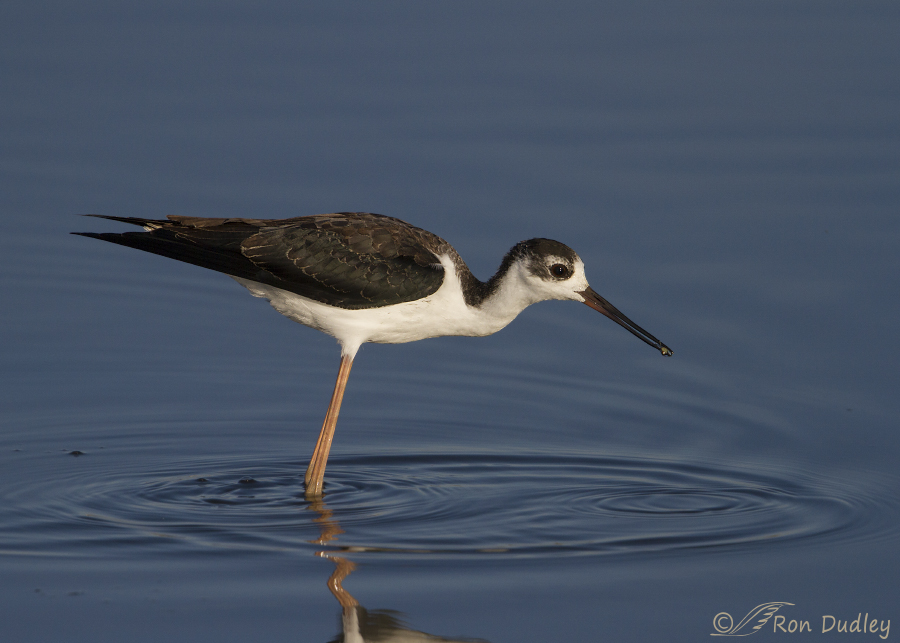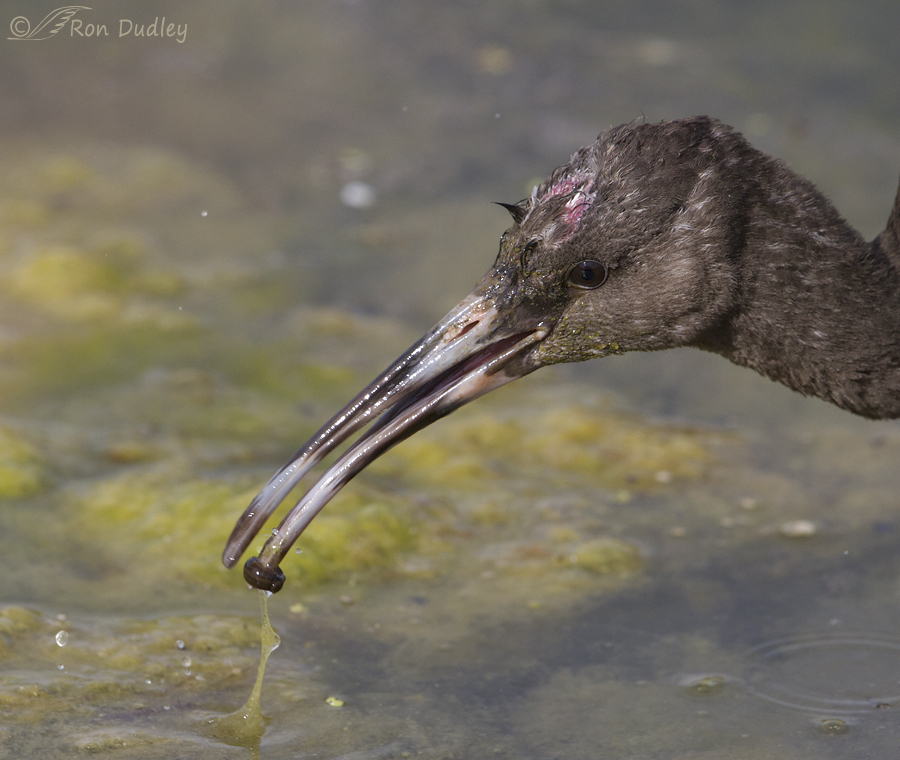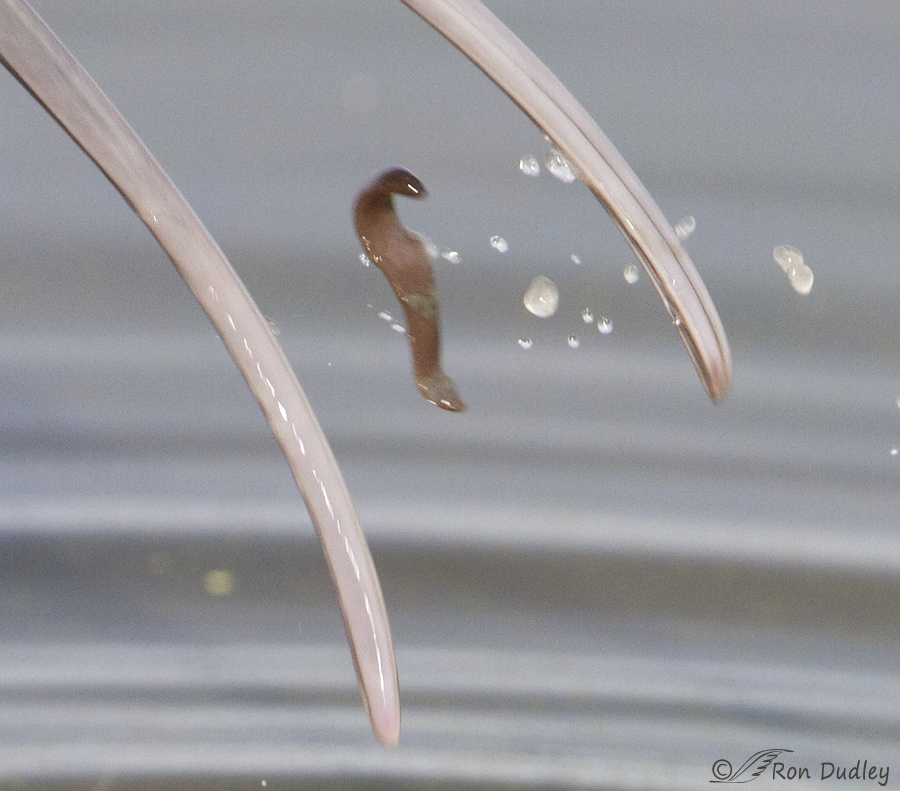Most of us are birders, photographers or nature-watchers to one degree or another and have spent many hours observing wading birds and shorebirds as they feed. Who among us has not been at least a little bit curious about precisely what they’re eating? The retired biology/zoology teacher in me constantly wonders about such things as I watch birds like stilts, avocets and ibis as they feed through my viewfinder.

1/4000, f/6.3, ISO 500, Canon 7D, Canon EF500mm f/4L IS II USM +1.4 tc, not baited, set up or called in
We’re aware that many of these birds eat a variety of “aquatic invertebrates” but that is a very generic and non-specific answer that might include larval and adult insects, crustaceans, molluscs, three phyla of worms and others. We’re literally talking about millions of species that are potential prey. And some of these birds also eat vertebrates like small fish and frogs.
Usually when these birds are feeding we see only the behavior – the action is too quick and the prey too small for us to be specific about what they’re actually consuming. Sometimes, as with this juvenile Black-necked Stilt I photographed recently, when I look at the images I can see the prey but it’s much too small to identify. But usually I can’t even tell what they’re eating…

1/1600, f/7.1, ISO 500, Canon 7D, Canon EF500mm f/4L IS II USM +1.4 tc, not baited, set up or called in
even when they’re unusually close to me. This juvenile White-faced Ibis with a wound on the top of its head (I know nothing about the origin of the injury) fed unusually close to me a few weeks ago and even though I can see the prey clearly I cannot identify it – it could be any number of worms or larval insects or something else.
However, on that same morning an adult ibis fed so close to me that I was near the focusing limit of my lens so I decided to see if I could time a few shots to catch the prey in the air when the bird tossed it up to swallow and then attempt to identify it.

1/1600, f/7.1, ISO 500, Canon 7D, Canon EF500mm f/4L IS II USM +1.4 tc, not baited, set up or called in
One time I succeeded. The prey item was a planarian – a non-parasitic flatworm related to the parasitic tapeworms and flukes. It can be identified by its flattened body, the triangular-shaped head at bottom and (if you look very, very closely) the two dark eyespots on the top of the head. Some may remember this worm from their life science classes as it has been extensively studied for its remarkable powers of regeneration.
I’m not entirely sure why making this positive ID gave me as much satisfaction as it did. Perhaps it’s a combination of my biology background (bio-geekiness?) and the photographic challenge it presented with a wild bird.
But I was pleased to have done it.
Ron
Addendum: Apparently this biologist got it wrong and this is likely a leech rather than a planarian. Matt Tagg made the following explanatory Facebook comment on my post and it sounds like he knows what he’s talking about. I figured that the prey in the second shot might be a leech but the critter in the last image sure looked like a planarian to me. I should have known better, based on its relatively large size (as mentioned by Alison in a comment).
- “Ron, those birds are eating leeches, most likely the family Erpobdellidae. The leeches have two to as many as 8 eyespots, depending on the genus/species. Leeches typically curl like that when stressed. Planarians don’t get much more than 8-10mm long when stretched out and they “shrink” up when stressed. I’ve seen literally hundreds of thousands of them through the scope at work. The habitat where these type of birds would be feeding is prime for leeches, lentic (standing/slow water). Planarids tend to live more in lotic (moving water) systems, although both do occur in each. Hope this helps.”
When I asked Matt if the triangular-shaped head in the last image didn’t look like that of a planarian, he responded:
- “It does. However you only see the triangular head pattern when the planarian is relaxed and stretched out. Almost always when I see them they are retracted and look like a indiscernible hunk of flesh.
I think what you are seeing is the oral sucker of the leech. It is more muscular and defined than the rest of the body. Leeches are very “plastic”. In other words, they can manipulate their bodies all over the place. They can go from a very flattened long body form to a tight squatty body form in the blink of an eye. When threatened they will squirm every which way and then ball up. Which is what I think you captured in your picture. Your pictures demonstrate very well what I’m talking about. The close up picture shows a leech that is extended and flattened. The picture with it wrapped around the bird’s beak shows a leech tightly balled up in a defensive reaction.
I would bet that both of the leeches in the pictures are probably the same genus, just in different reactive forms.”


Are you sure that wasn’t a KELLOG CORN FLUKE that bird was having for breakfast??? It looked so unappetising I was almost unable to finish my vole!
Leeches are low on my list of ‘preferred critters’ since the day 9walking in a rain forest) I picked up more than twenty including one which found its way into my ear. You are so very right about the buckets of blood.
Just the same, I do love the way you feed my curiosity and love of beauty each and every day.
That was an experience I’ll remember, Elephant’s Child. The leech crawled up my leg (under my blue jeans) to the back of my knee and apparently fed there for much of the day. That’s a very effective anticoagulant that they use…
Shudder. I thought it was a leech too!
Great shots Ron, many thanks for the lesson!!
Thanks, Dick. Obviously it was a lesson for me, too.
And it looks like, in picture 2, that its’ holding on to the bill (wrapped around) for dear life! Ever wonder if it knows where it’s going to wind up?
I don’t think they “know” much of anything, Alan.
Terrific shot Ron, either your timing is spot on or your burst series was, lol. Regardless, great capture!
Are the parasite’s in these same waters, if so does you “Biogeekiness” tell you if they’d infect this bird?
Thanks again for an informative as well as enjoyable site.
Alan
Alan, as you may know there are many species of leeches and only some of them are parasites. I don’t know if these are “blood-suckers” or not but I do know that we have them here in northern Utah because I got one on the back of my knee once while fishing at Strawberry Reservoir. Didn’t know I had it till I got almost home. They have an anticoagulant in their saliva so there was lots of blood…
But in answer to your question, I personally have never seen a leech on a bird – another practical use of feathers and scales I suspect.
It is fun to identify what the birds are eating. We are currently at the beach (Outer Banks) and now that the tourists are mostly gone the Sanderlings and Willets have reappeared on the beach. We have been watching their feeding behavior, and still can’t figure out what the Sanderlings are going after, but we’ve been able to see clearly that the Willets are eating a crustacean we’ve always called ‘sand crabs’ (pinkish shell – in my research I’ve found they’re also called sand fleas or mole crabs). What that ID has done for me is satisfy my curiosity. I think that once a biologist/naturalist, always a biologist/naturalist. That curiosity never dies. And that’s one of the things that keeps life interesting.
I’m glad you have that curiosity too, Susan. I think many of us do and that’s a good thing…
Amen, Margie! (Or is it, Ah! Men!)
I once read in some science journal that some planaria were trained to execute a simple maze. Then they were ground up and fed to a new, untrained batch of planaria. The new batch were able to execute the maze without training. I think this was in the mid 70’s. I believe the concept being tested was genetic memory… I think the journal may have been British…ring any bells? I remember well working with planaria in college, and their amazing ability to regerate heads, tails, missing sides, etc. I remember thinking , “If we could only figure out and replicate this process, we could regerate all kinds of injured and missing body parts”. And I was quite convinced that someday we would. I can also remember planaria’s funny looking “crossed eyes”…
Patty, I remember hearing about the ground-up planaria being fed to uneducated ones and the passing on of the learning that way from when I was in college in the 1960s. This was info I got from one of my professors, don’t know the source. It’s a fun subject/memory to revisit.
Patty, I used to teach my kids about that study, too. I believe it was an English study. The last I heard the “chemical memory” theory was discarded because they figured the planaria were actually following chemical trails from previous trips rather than assimilating memory from the worms they had eaten.
I just love your site. Your photos are beautiful, but we’re also treated to information about the subjects that we wouldn’t typically get on a typical photography site. Plus you’re funny! (Bio-geekiness!) I always look forward to coming here to see what you’ve got for us today.
I appreciate your observations on all three counts, Marjie. A lot. Thank you.
Absolutely amazing Ron! Thanks for sharing!
Charlotte
Thank you, Charlotte.
My heavens, I had no idea planaria could be so large! Somehow the word ‘fluke’ came to mind. Whatever it is, I’m happy to leave it to the birds to eat! The very occasional eel is as close as I get to this kind of fare. Thanks (I think!) for treating me to this vision before breakfast!
It really isn’t very big, Alison – perhaps the bill of the bird makes it appear larger than it is. And planaria are very closely related to flukes. Happy corn flakes!!!